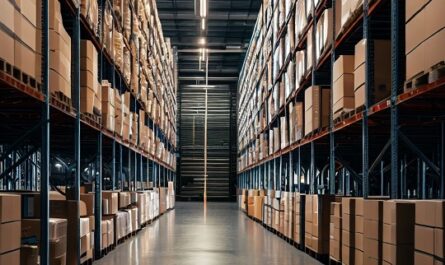The global economy is a delicate web of interconnections, where every decision, every shift in policy, and every international event can have a ripple effect across businesses everywhere. In recent years, we’ve seen how economic and political disruptions, particularly trade tariffs, can wreak havoc on the bottom lines of businesses. For many companies, these changes lead to difficult decisions on how to navigate increased costs without sacrificing profitability or alienating customers.
The concept of a trade war—intensified by rising tariffs—has been a key challenge for businesses, especially those who depend on cross-border trade. When tariffs increase, the immediate impact can be seen on a business’s supply chain, pricing strategies, and even customer relations. So, the big question remains: How can businesses maintain their competitive edge and protect their profit margins when facing the weight of these changes?
The solution lies, in many ways, in the very heart of a business—their supply chain. This often-overlooked aspect of business operations is where much of the magic happens, especially when times get tough. In this blog post, we’re going to dive deep into the role that supply chain strategies play in helping businesses absorb the costs brought on by rising tariffs, and how companies can use their supply chain as a tool to mitigate the impacts of external economic disruptions.
Whether you’re a business owner, a supply chain manager, or part of the C-suite, this exploration will help you understand how optimized supply chains can serve as your first line of defense against tariffs and how businesses can continue to thrive in challenging times.
Before we go further into this topic, don’t forget to follow my LinkedIn account. You’ll get more helpful insights on supply chain management there.
Table of Contents
The Reality of Trade Tariffs: An Unseen Battle
Tariffs are not a new concept, but their resurgence in recent years has caught many businesses off guard. Trade wars, which involve one country imposing tariffs on another, are part of a broader strategy used by governments to protect domestic industries, incentivize production within their own borders, or punish other nations for perceived unfair trade practices. For businesses, this means higher costs for raw materials, components, and finished products imported from overseas.
The most direct impact of rising tariffs is often seen in the price increase of goods. Companies that rely on imported products or raw materials can face a sudden spike in the cost of their materials. For example, in the automotive or electronics industries, companies might find that the parts they need are now significantly more expensive. If the business does not have a strategy in place to absorb these costs, these price increases will almost inevitably trickle down to the customer.
However, there’s another layer to this. The rise in tariffs doesn’t just affect the price of individual items—it affects everything from supply chain logistics to sourcing strategies. For instance, as shipping costs rise due to increased tariffs, companies must reevaluate their methods of transportation and decide whether to pass those costs on to consumers or take the hit themselves.
But here’s the thing: while tariffs increase costs, they don’t necessarily dictate the fate of a business. Companies can adopt various strategies to offset these impacts, and the first and most important area to address is the supply chain.
You might also like:
- Mastering Economic Order Quantity (EOQ) to Slash Costs and Boost Efficiency
- Why Your Supply Chain Recommendations Get Ignored and What to Do About It
The Role of the Supply Chain in Mitigating Tariff Costs
The supply chain is often described as the backbone of any business. From raw material procurement to product delivery, the way a business manages its supply chain can determine how effectively it can respond to rising tariffs. In fact, an optimized supply chain can help a company absorb a significant portion of the cost increase and minimize the damage caused by tariffs.
Think of your supply chain as a series of interconnected systems: suppliers, manufacturers, distributors, and logistics partners, all working in tandem to deliver products to consumers. When a tariff increases, the supply chain is the first place to feel the impact. This means that by making smart, calculated decisions within this chain, a business can reduce the amount of cost that gets passed along to the consumer.
Here’s how companies can leverage their supply chains to offset tariff hikes.
Diversifying Suppliers: The Power of Choice
One of the most immediate ways businesses can mitigate the impact of tariffs is by diversifying their supplier base. Many businesses rely on a single source for their raw materials or components. If this source is located in a country facing high tariffs, then the company has little choice but to bear the brunt of the cost increases.
However, businesses that rely on a broader network of suppliers have more room to maneuver. By sourcing materials from countries with lower tariffs or even from domestic sources, a company can significantly reduce its reliance on any one supplier. This not only helps businesses avoid the costs of tariffs but also provides a level of flexibility when navigating changes in the global marketplace.
Diversification also reduces the risk of supply chain disruptions caused by geopolitical tensions. As global trade policies shift, having a broader supplier network can insulate businesses from the impact of tariffs on a specific region or country.
Nearshoring and Reshoring: Bringing Production Closer to Home
While diversification of suppliers is a valuable strategy, some businesses may find that nearshoring or reshoring their production to their home country is an even more effective way to mitigate tariffs. Nearshoring refers to relocating production closer to the consumer market, while reshoring means bringing production back to the home country.
By moving production closer to home or even within the same region, businesses can avoid high import tariffs on raw materials or finished goods. Additionally, nearshoring or reshoring can lead to improved delivery times, reduced shipping costs, and greater control over production processes.
The trade-off here, of course, is the initial investment required to set up new facilities or negotiate new agreements with local suppliers. However, businesses that make this investment early on may find that the long-term benefits—such as lower operating costs and greater control over supply chain risks—far outweigh the upfront costs.
Optimizing Logistics: The Art of Cost-Efficient Shipping
Tariffs often directly affect shipping and logistics costs. Import duties on products and raw materials can cause transportation costs to rise. This makes it even more critical for businesses to optimize their logistics network to counterbalance these increases.
A business’s logistics operations must be agile and cost-efficient in the face of rising tariffs. By reevaluating shipping routes, consolidating shipments, and negotiating with carriers, companies can reduce the overall impact of increased transportation costs. For example, consolidating shipments into larger volumes or using multimodal transport can reduce per-unit shipping costs, allowing the business to maintain profitability despite higher tariffs.
Additionally, leveraging advanced data analytics and tracking technologies can help businesses make better decisions regarding inventory levels, order fulfillment, and shipping schedules. By anticipating changes in demand and adjusting shipping strategies accordingly, businesses can avoid unnecessary shipping costs and pass on fewer expenses to customers.
Improved Inventory Management: Minimizing Excess Costs
Inventory management is another key area where businesses can make a significant impact. When tariffs rise, businesses often feel the pressure to stockpile materials or goods in anticipation of future price increases. However, holding large quantities of inventory can lead to increased carrying costs and reduced cash flow.
By implementing advanced inventory management systems, businesses can better predict demand and avoid overstocking. This allows them to purchase only the materials they need at the right time, avoiding unnecessary storage costs and the potential loss of goods due to market changes.
Additionally, businesses that adopt just-in-time (JIT) inventory systems or lean manufacturing techniques can further streamline their operations and reduce the need for excess inventory. By focusing on efficiency and demand-driven production, companies can absorb tariff increases without being forced to pass those costs on to customers.
The Limits of Absorbing Tariff Increases
Despite all the strategies above, there are limits to how much businesses can absorb. At a certain point, rising tariffs will overwhelm the supply chain’s ability to offset costs. While supply chain optimization can help to mitigate the impact of tariffs, it cannot completely eliminate the financial burden. At some point, businesses will have to consider price adjustments.
For businesses that operate in highly competitive markets or those with slim profit margins, absorbing tariff increases without raising prices may not be sustainable. In these cases, companies must weigh the pros and cons of price hikes versus the potential loss of customers. For example, a business that can no longer afford to absorb tariff costs may decide to raise prices slightly, but it risks losing customers if competitors can offer similar products at lower prices.
This is the delicate balancing act that businesses must navigate: absorbing some of the costs through supply chain strategies while also being prepared to raise prices or adjust margins to stay financially viable.
You might also like:
- Mastering Warehouse Layout for Seamless Workflow and Maximum Efficiency
- How to Avoid Losing Money on Delivery Costs When Customer POs Are Small
Customer-Centric Pricing Strategies in the Face of Tariffs
As difficult as it may be, raising prices becomes almost inevitable when tariffs climb too high. However, the way a company handles this price increase can make all the difference in customer retention.
One of the most effective ways to approach pricing adjustments is through gradual increases. Instead of slapping customers with a dramatic price hike all at once, companies can opt for smaller, incremental price increases over time. This allows customers to adjust and reduces the shock of sudden price jumps.
Additionally, transparent communication is crucial. Customers are far more likely to accept price increases if they understand the reasoning behind them. By explaining that the price hike is a result of external factors, such as higher tariffs, businesses can maintain trust and loyalty. Offering value-added services or reinforcing the quality of the product can also help justify price increases and retain customers who might otherwise look for cheaper alternatives.
Lastly, businesses can look into bundling products or offering promotional deals that create a sense of added value without reducing their profit margins. This can make the price increase feel more palatable to customers, giving them a sense that they are receiving more for their money despite higher costs.
Looking Ahead: Long-Term Strategic Planning
While dealing with tariffs and rising costs is an immediate challenge, businesses should also be thinking long-term. As trade policies continue to evolve and tariffs fluctuate, having a robust long-term strategy will help companies stay ahead of the curve. This strategy should focus on diversifying supply chains, investing in technology, and building strong relationships with local and international suppliers.
Furthermore, businesses that engage in scenario planning will be better equipped to handle future disruptions. By simulating different tariff scenarios and planning for a range of outcomes, businesses can prepare for the worst-case scenario while positioning themselves for opportunities that arise from changes in trade policies.
Technology, too, plays a key role in future-proofing a business. Investment in digital tools such as predictive analytics, artificial intelligence, and automated supply chain management systems can help businesses stay agile and adjust quickly to changes in the global economy. By leveraging these tools, companies can make better decisions faster, reducing the impact of tariff-related price increases and ensuring a more resilient business model.
Conclusion: The Path Forward
The rise of tariffs and trade wars is a reality that businesses must face head-on. However, rather than viewing this as an insurmountable challenge, companies can leverage their supply chain to mitigate the impact and continue to operate profitably. Through supplier diversification, nearshoring, logistics optimization, and effective inventory management, businesses can absorb some of the increased costs that come with tariffs.
But, as with any business decision, there are limits. The point at which absorbing costs becomes unsustainable will differ depending on the industry, the product, and the market conditions. Pricing adjustments will inevitably become necessary at some point, but how these price increases are communicated and implemented can determine whether customers remain loyal.
Ultimately, businesses that are proactive in optimizing their supply chains and prepared to adjust their pricing strategies will be better positioned to weather the storm of rising tariffs. With the right strategies in place, not only can businesses survive in challenging times—they can emerge stronger and more competitive in the long term.
I hope you find it helpful!
Please share this article with your colleagues so they can also benefit. For more insights on supply chain management, follow my LinkedIn account. You’re free to use all articles on this blog for any purpose, even for commercial use, without needing to give credit.
 by
by 

